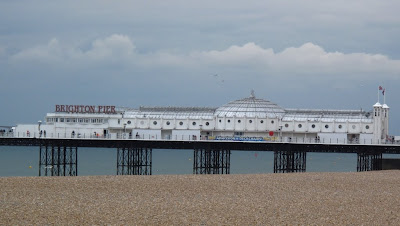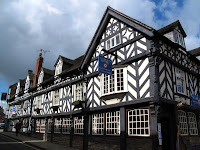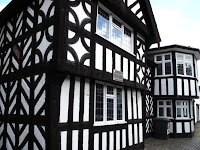

After spending the night in a suburb of North Manchester, we were perfectly placed to start the day with a look around the city. The outskirts of Manchester looked very depressed, with closed shops and boarded up buildings everywhere. The city centre seemed to have survived the recession, and we enjoyed walking around the buildings reflecting the grander styles of past eras, and modern look of glass and copper at The Lowry re-development of the docklands area.

The highlight of Manchester was a visit to the John Ryland Library. The wife of this Victorian industrialist built the library, which opened in 1900, to commemorate his life. She chose a Gothic style to compete with the great libraries at Cambridge and Oxford, and the building is stunning. There is a large Reading Room, and smaller rooms filled with interesting exhibitions.


From Manchester we travelled the short distance south back to Liverpool. Once again, the outer areas looked very sad, with many closed premises, and the city centre itself is a mixture of grand, but tired buildings and livelier but equally shabby areas. A good proportion of the city centre is now a UNESCO heritage site, and we were frankly not sure why. But the heritage area of the Albert Docks, is also UNESCO, and this is a total delight to spend time in. The old dock buildings have been given a new lease of life as shops, restaurants, cafes and museums.


A 30 minute walk uphill, leads to the Metropolitan Cathedral. This Catholic church, opened in 1967, is dramatic in design both inside and out. The lantern is the largest lead light window in the world and combined with the blue leadlight windows around the circular building, fills the whole auditorium with a blue glow.

A short walk along Hope Street took us to the Philharmonic Dining Room. This equally dramatic building, originally for pre or post-show gatherings, is definitely worth a visit. The look downstairs is of an opulent Gentlemen's club, complete with the only Grade 1 listed Gents in the UK, which ladies are able to inspect if the coast is clear.

When we visited, although reasonably early in the evening, the place was already bustling with people clutching their glasses while standing in the only places available – the corridors. Upstairs is much more peaceful (and also less grand, as it was the room the carriage drivers used to wait in) and we were one of only two tables enjoying a very nice and quiet meal.

 It seems as though it would be impossible to run out of new places to visit in London. This weekend we made two new discoveries, of an annual event on Saturday, and a pumping station, nearly 100 years old, on Sunday when we discovered the Kempton Great Engines. Built in the art deco era, this handsome building, totally lined with glazed bricks inside, has had one of the great steam engines
It seems as though it would be impossible to run out of new places to visit in London. This weekend we made two new discoveries, of an annual event on Saturday, and a pumping station, nearly 100 years old, on Sunday when we discovered the Kempton Great Engines. Built in the art deco era, this handsome building, totally lined with glazed bricks inside, has had one of the great steam engines  restored to working condition, and Sunday was of the 14 steaming days in the year. The two great engines were built to pump drinking water to London, and the guided tour, was a fascinating look at the technology developed to cope with this task. Each engine is 62ft, or 4 storeys, tall and not only are the engines on a large scale, some of the spanners used in their construction and maintenance take three men to lift them.
restored to working condition, and Sunday was of the 14 steaming days in the year. The two great engines were built to pump drinking water to London, and the guided tour, was a fascinating look at the technology developed to cope with this task. Each engine is 62ft, or 4 storeys, tall and not only are the engines on a large scale, some of the spanners used in their construction and maintenance take three men to lift them.

 The engines were designed and built in the north, tested and then disassembled into numbered parts each of which weighed a maximum of 16 tons and could fit into a standard railway wagon of the time. The work and expertise that went into the engines is quite remarkable considering that, possibly, only 4 were made. They served over 50 years until the 1980s and were more efficient than the turbine driven centrifugal pumps that were installed to replace them.
The engines were designed and built in the north, tested and then disassembled into numbered parts each of which weighed a maximum of 16 tons and could fit into a standard railway wagon of the time. The work and expertise that went into the engines is quite remarkable considering that, possibly, only 4 were made. They served over 50 years until the 1980s and were more efficient than the turbine driven centrifugal pumps that were installed to replace them. Ultimately progress passed them by and instead of 140 men the site now employes 14 men, electric pumps and electronic controls, all incredibly boring compared to the grandeur of these great behemoths of the steam age.
Ultimately progress passed them by and instead of 140 men the site now employes 14 men, electric pumps and electronic controls, all incredibly boring compared to the grandeur of these great behemoths of the steam age.













































